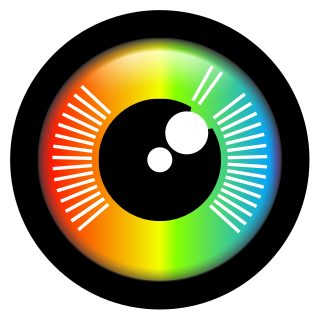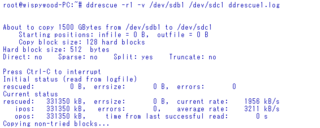
In information theory and coding theory with applications in computer science and telecommunications, error detection and correction (EDAC) or error control are techniques that enable reliable delivery of digital data over unreliable communication channels. Many communication channels are subject to channel noise, and thus errors may be introduced during transmission from the source to a receiver. Error detection techniques allow detecting such errors, while error correction enables reconstruction of the original data in many cases.
RAID is a data storage virtualization technology that combines multiple physical data storage components into one or more logical units for the purposes of data redundancy, performance improvement, or both. This is in contrast to the previous concept of highly reliable mainframe disk drives known as single large expensive disk (SLED).

A live CD is a complete bootable computer installation including operating system which runs directly from a CD-ROM or similar storage device into a computer's memory, rather than loading from a hard disk drive. A live CD allows users to run an operating system for any purpose without installing it or making any changes to the computer's configuration. Live CDs can run on a computer without secondary storage, such as a hard disk drive, or with a corrupted hard disk drive or file system, allowing data recovery.
An optical disc image is a disk image that contains everything that would be written to an optical disc, disk sector by disc sector, including the optical disc file system. ISO images contain the binary image of an optical media file system, including the data in its files in binary format, copied exactly as they were stored on the disc. The data inside the ISO image will be structured according to the file system that was used on the optical disc from which it was created.
Data degradation is the gradual corruption of computer data due to an accumulation of non-critical failures in a data storage device. It is also referred to as data decay, data rot or bit rot. This results in a decline in data quality over time, even when the data is not being utilized. The concept of data degradation involves progressively minimizing data in interconnected processes, where data is used for multiple purposes at different levels of detail. At specific points in the process chain, data is irreversibly reduced to a level that remains sufficient for the successful completion of the following steps

Optical disc authoring, including CD, DVD, and Blu-ray Disc authoring, is the process of assembling source material—video, audio or other data—into the proper logical volume format to then be recorded ("burned") onto an optical disc.
Parchive is an erasure code system that produces par files for checksum verification of data integrity, with the capability to perform data recovery operations that can repair or regenerate corrupted or missing data.
In information technology, a backup, or data backup is a copy of computer data taken and stored elsewhere so that it may be used to restore the original after a data loss event. The verb form, referring to the process of doing so, is "back up", whereas the noun and adjective form is "backup". Backups can be used to recover data after its loss from data deletion or corruption, or to recover data from an earlier time. Backups provide a simple form of IT disaster recovery; however not all backup systems are able to reconstitute a computer system or other complex configuration such as a computer cluster, active directory server, or database server.

Data corruption refers to errors in computer data that occur during writing, reading, storage, transmission, or processing, which introduce unintended changes to the original data. Computer, transmission, and storage systems use a number of measures to provide end-to-end data integrity, or lack of errors.
CD/DVD copy protection is a blanket term for various methods of copy protection for CDs and DVDs. Such methods include DRM, CD-checks, Dummy Files, illegal tables of contents, over-sizing or over-burning the CD, physical errors and bad sectors. Many protection schemes rely on breaking compliance with CD and DVD standards, leading to playback problems on some devices.
In computing, data recovery is a process of retrieving deleted, inaccessible, lost, corrupted, damaged, or formatted data from secondary storage, removable media or files, when the data stored in them cannot be accessed in a usual way. The data is most often salvaged from storage media such as internal or external hard disk drives (HDDs), solid-state drives (SSDs), USB flash drives, magnetic tapes, CDs, DVDs, RAID subsystems, and other electronic devices. Recovery may be required due to physical damage to the storage devices or logical damage to the file system that prevents it from being mounted by the host operating system (OS).
In computing, an archive file is a computer file that is composed of one or more files along with metadata. Many archive formats also support compression of member files. Archive files are used to collect multiple data files together into a single file for easier portability and storage, or simply to compress files to use less storage space. Archive files often store directory structures, error detection and correction information, comments, and some use built-in encryption.
A cue sheet, or cue file, is a metadata file which describes how the tracks of a CD or DVD are laid out. Cue sheets are stored as plain text files and commonly have a .cue filename extension. CDRWIN first introduced cue sheets, which are now supported by many optical disc authoring applications and media players.
IMG, in computing, refers to binary files with the .img filename extension that store raw disk images of floppy disks, hard drives, and optical discs or a bitmap image – .img.

PhotoRec is a free and open-source utility software for data recovery with text-based user interface using data carving techniques, designed to recover lost files from various digital camera memory, hard disk and CD-ROM. It can recover the files with more than 480 file extensions . It is also possible to add custom file signature to detect less known files.

A bad sector in computing is a disk sector on a disk storage unit that is unreadable. Upon taking damage, all information stored on that sector is lost. When a bad sector is found and marked, the operating system like Windows or Linux will skip it in the future. Bad sectors are a threat to information security in the sense of data remanence.

In computer disk storage, a sector is a subdivision of a track on a magnetic disk or optical disc. For most disks, each sector stores a fixed amount of user-accessible data, traditionally 512 bytes for hard disk drives (HDDs), and 2048 bytes for CD-ROMs, DVD-ROMs and BD-ROMs. Newer HDDs and SSDs use 4096 byte (4 KiB) sectors, which are known as the Advanced Format (AF).

GNU ddrescue is a data recovery tool for disk drives, DVDs, CDs, and other digital storage media. It copies raw blocks of storage, such as disk sectors, from one device or file to another, while handling read errors in an intelligent manner to minimize data loss by scraping good sectors from partially read blocks.

A CD-ROM is a type of read-only memory consisting of a pre-pressed optical compact disc that contains data computers can read, but not write or erase. Some CDs, called enhanced CDs, hold both computer data and audio with the latter capable of being played on a CD player, while data is only usable on a computer.

Advanced Format (AF) is any disk sector format used to store data in HDDs, SSDs and SSHDs that exceeds 528 bytes per sector, frequently 4096, 4112, 4160, or 4224-byte sectors. Larger sectors of an Advanced Format Drive (AFD) enable the integration of stronger error correction algorithms to maintain data integrity at higher storage densities.










